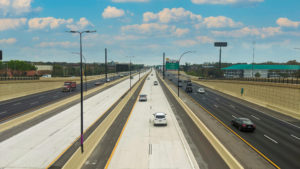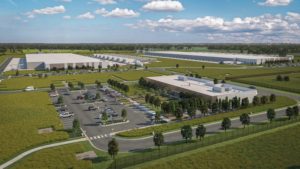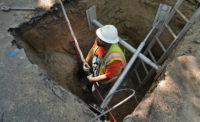Looking into the coming year, experts are cautiously optimistic that a stronger construction market lies ahead, particularly in certain markets.
“As we go into 2024, we’re starting to see economic growth become more consistent and accelerating by the end of the year,” says Richard Branch, chief economist at Dodge Construction Network. However, he adds, this is dependent on the assumption that the Federal Reserve is done raising interest rates. Dodge forecasts that rates will begin to fall in the middle of 2024.
Branch also points to labor issues, citing the recent United Auto Workers strike, which “certainly took a little bit out of Q3 and Q4 GDP.” He also cited rising tensions in Russia, Ukraine and the Middle East as possible obstacles in the coming year. “Geopolitical risk remains intense,” he says, but Dodge forecasts that “tensions will start to ease in the coming three to six months.”
The overall value of construction starts is expected to rise 7% in 2024, following a 1% increase in 2023, according to the Dodge forecast. The 2023 boost will bring total starts value to $1.124 trillion, with $1.206 trillion forecast for 2024.
DODGE CONSTRUCTION STARTS FORECAST: 2024 (IN $BIL)
| ACTUAL 2022 | ESTIMATE 2023 | FORECAST 2024 | %CHG. '22-'23 | %CHG. '23-'24 | |
| TOTAL CONSTRUCTION | 1,117.1 | 1,123.6 | 1,205.8 | +1 | +7 |
| RESIDENTIAL | 418.4 | 364.8 | 405.6 | –13 | +11 |
| SINGLE-FAMILY HOUSING | 265.2 | 223.7 | 244.4 | –16 | +9 |
| MULTIFAMILY HOUSING | 153.1 | 141.1 | 161.2 | –8 | +14 |
| NON-RESIDENTIAL | 443.9 | 440.6 | 458.4 | –1 | +4 |
| OFFICE BUILDINGS | 53.4 | 56.1 | 55.2 | +5 | –2 |
| HOTELS AND MOTELS | 12.6 | 11.9 | 13.9 | –6 | +17 |
| STORES AND SHOPPING CENTERS | 19.4 | 19.6 | 21.4 | +1 | +9 |
| WAREHOUSES | 60.2 | 49.6 | 44.3 | –18 | –11 |
| MANUFACTURING | 102.1 | 96.8 | 112.0 | –5 | +16 |
| EDUCATIONAL BUILDINGS | 74.5 | 82.5 | 86.0 | +11 | +4 |
| HEALTH CARE FACILITIES | 37.4 | 37.0 | 39.0 | –1 | +5 |
| OTHER NON-RESIDENTIAL | 84.2 | 86.9 | 86.7 | +3 | 0 |
| NON-BUILDINGS CONSTRUCTION | 254.9 | 318.3 | 341.8 | +25 | +7 |
| HIGHWAYS AND BRIDGES | 105.0 | 119.5 | 147.1 | +14 | +23 |
| ENVIRONMENTAL PUBLIC WORKS | 65.1 | 75.3 | 83.1 | +16 | +10 |
| OTHER NON-BUILDING | 28.9 | 36.6 | 39.6 | +27 | +8 |
| POWER PLANTS/GAS/COMMUNICATIONS | 55.9 | 86.9 | 72.1 | +56 | –17 |
| SOURCE: Dodge Construction Network | |||||
FMI CONSTRUCTION PUT-IN-PLACE FORECAST: 2024 ($ BIL)
| %nbsp; | ACTUAL 2022 | ESTIMATE 2023 | FORECAST 2024 | %CHG. '22-'23 | %CHG. '23-'24 |
| TOTAL CONSTRUCTION | 1,848.7 | 1,933.1 | 1,929.9 | +4.6 | –0.2 |
| TOTAL RESIDENTIAL | 927.4 | 874.9 | 813 | –5.7 | –7.1 |
| SINGLE-FAMILY | 453.7 | 392.5 | 354.2 | –13.5 | –9.8 |
| MULTIFAMILY | 118.5 | 140.2 | 130.9 | +18.3 | –6.6 |
| HOME IMPROVEMENT | 355.3 | 342.2 | 327.8 | –3.7 | –4.2 |
| TOTAL NON-RESIDENTIAL | 631.8 | 738 | 772.2 | +16.8 | +4.6 |
| LODGING | 19.7 | 22.9 | 23.7 | +16.1 | +3.6 |
| OFFICE | 91.6 | 98.5 | 94.2 | +7.5 | –4.4 |
| AMUSEMENTS AND RECREATION | 30 | 32.4 | 33.6 | +8.0 | +3.8 |
| RELIGIOUS | 2.9 | 3.1 | 3.1 | +4.1 | +1.3 |
| EDUCATION | 102.1 | 110.2 | 117.4 | +7.9 | +6.6 |
| HEALTH CARE | 54.8 | 59.9 | 63.3 | +9.4 | +5.6 |
| COMMERCIAL | 121.3 | 129.2 | 117.6 | +6.4 | –8.9 |
| MANUFACTURING | 114.7 | 181.5 | 209 | +58.2 | +15.1 |
| PUBLIC SAFETY, ADMINISTRATIVE | 11.6 | 12.6 | 13.8 | +8.6 | +9.9 |
| TRANSPORTATION | 58.7 | 63 | 70.7 | +7.3 | +12.1 |
| NON-BUILDING STRUCTURES | 289.4 | 320.2 | 344.8 | +10.6 | +7.7 |
| CONSERVATION AND DEVELOPMENT | 9.4 | 11.1 | 12.2 | +17.3 | +9.9 |
| HIGHWAYS AND STREETS | 114.1 | 128 | 139 | +12.1 | +8.6 |
| SEWER SYSTEMS | 32.7 | 38.6 | 42.1 | +18.1 | +9.1 |
| POWER | 109.8 | 115.5 | 122.7 | +5.2 | +6.2 |
| WATER SUPPLY | 23.4 | 27 | 28.9 | +15.6 | +7.0 |
| SOURCE: FMI CORP., HISTORICAL DATA ARE COMPILED FROM BUILDING PERMITS, CONSTRUCTION PUT-IN-PLACE AND TRADE SOURCES. ESTIMATES FOR 2023 AND FORECAST FOR 2024 BY FMI. | |||||
Modest Growth for Housing Starts
The total dollar value of residential starts is expected to end the year down 13%, before rising 11% in 2024. Single-family starts are down 16% in 2023, with a predicted increase of 9% next year. “There’s a growing sense here that the single-family market is at least past the bottom,” says Branch. “But with mortgage rates where they are it’s not as though we’re going to see some huge big run up here in single-family construction any time soon.”
“There’s a growing sense here that the single-family market is at least past the bottom.”
-Richard Branch, Chief Economist, Dodge Construction Network
Alex Carrick, chief economist at ConstructConnect, shares the sentiment that falling rates are the key to a thriving residential market. “As interest rates stabilize and then begin to decline after Q1 or Q2 of next year, the homebuilding sector will revive.” ConstructConnect’s forecast predicts a 4.4% increase in 2024 for total residential starts, with a more robust 15% increase expected the following year.
Multifamily starts are forecast to end 2023 down 8%, with a rebound of 14% next year, according to Dodge data. Following a peak at the end of 2022, starts in this sector have declined, due in part to tightening credit standards for multifamily and commercial properties, as well as younger people cohabitating or living with family, lowering demand. Still, says Branch, this is simply a fall from the peak of activity. “These are the highest levels of multifamily construction back to the 80s,” he adds. “So there’s still a lot of activity going on.”






The commercial sector, which include stores, offices, warehouses, hotels and parking, is expected to end 2023 down 6%, falling 2% in 2024, Dodge predicts. The decline “really comes down to one sector, and it’s the warehouse sector,” says Branch. Amazon, which accounted for 16% of all warehouse construction, “essentially stepped aside,” which required a “realignment that continues in 2024” for warehouse construction, he adds. Dodge forecasts warehouse starts will end 2023 down 18%, followed by an additional 11% next year.
“The outlook for data centers seems almost unbounded.”
-Alex Carrick, Chief Economist, ConstructConnect
Hotel starts are down 5% in 2023 but will increase 16% in 2024. “Hotel fundamentals are very solid,” says Branch, particularly in the high end market. “I hate to call anything recession proof, but those luxury and upscale projects are moving ahead whether the economy is slowing or not.”
Office starts are expected to decline slightly, at a rate of 2%, in 2024, following two years of growth at a rate of 30% in 2022, and an additional 5% in 2023. While demand for traditional office space still suffers in the wake of the pandemic, data centers are expected to have “aggressive growth” in 2023 and 2024, says Branch.
Carrick also singles out data centers in ConstructConnect’s forecast as the bright spot in the office market. “The high-office-vacancy real estate sector may cause grief for lenders, as more leases will be expiring, and allowed to lapse, and rent collections will suffer,” he says, “[but] with more forays into artificial intelligence, virtual reality gaming, blockchain accounting and cybersecurity awareness, the outlook for data centers seems almost unbounded.”
Funds Spur Public Works
Manufacturing starts continue to stay high. After a 217% increase in 2022, starts are expected to drop 5% in 2023 before rising 16% in 2024. Branch notes that availability of labor has been an obstacle in 2023, causing the slight downturn and pushing several projects into the coming year.
In the non-building sector, total starts are forecast to increase 25% by the end of this year, and rise 7% in 2024. This is largely due to funds from the Infrastructure Investment and Jobs Act. In the transportation sector, both bridge and street construction starts are forecast to end this year up 14%. In 2024, bridge projects are predicted to increase 25%, while street construction will rise 23%. Dodge forecasts that following obstacles in 2023 caused by delays to appropriation bills passing and high materials costs, 2024 and 2025 will be “the best years for growth in infrastructure,” says Branch.
Alison Black, senior vice president and chief economist at the American Road & Transportation Builders Association says transportation activity is expected to increase or remain at the same level in 38 states in the coming year, among them Texas, Florida, Georgia and New York.
“This is driven by continued spending related to the federal infrastructure bill, as well as state spending,” she says. “Many states are increasing their own revenues to match federal funds and make additional transportation investments.”
Housing Starts Down in 2023, 2024


Residential construction will fall 11% in 2023, dropping an additional 3.4% in 2024, says the National Association of Home Builders. Single-family home construction is expected to fall 9.2% by the end of 2023 before rising 3.7% in 2024. Multifamily structure work will see a sharper decline of 14.6% in 2023 followed by a 17.3% decrease next year. The falloff is due to “over 1 million [units currently] under construction,” says Danushka Nanayakkara-Skillington, association assistant vice president for forecasting and analytics.
A New Perspective
“The outlook for data centers seems almost unbounded.”
-Alex Carrick, Chief Economist, ConstructConnect
The construction put-in-place forecast published by FMI Corp. predicts a 4.6% rise in the dollar value of total construction in 2023, with a slight falloff of 0.2% in 2024. “It’s really important that we maintain perspective looking at the forecast,” says Jay Bowman, a principal of the industry management consultant. “[The forecast] is flat, but it sure is planted at a really high level even when you adjust for inflation.”
Private construction will be the weakest in the coming year, says Bowman. The forecast for the residential market will fall 5.7% by the end of the year, with another 7.1% decrease next year. Commercial work is set to rise 6.4.% in 2023 but decline 8.9% in 2024.
“What we’re seeing from an interest rate perspective, it’s hard for developers to make the returns, and they’re going to seek returns elsewhere,” Bowman says, adding that some private construction, such as multi-family and retail, could be down close to 20% by 2025 compared to today.
Highway, Bridge Work Will Continue to Grow in 2024

The American Road & Transportation Builders Association estimates total spending for highway and bridge construction will rise 16% in 2024, following a 15% boost in 2023. “Transportation construction market activity is expected to increase or be steady in 38 states,” says Alison Black, senior vice president and chief economist at ARTBA. Highway work is set to rise 16.4% in 2023 and 15.9% in 2024, while bridge construction is up 8.2% in 2023, with an expected boost of 17.3% in 2024.
Among the stronger sectors is health care, which FMI forecasts will end 2023 up 9.4%, with an additional increase of 5.6% in 2024. While hospital construction has been relatively flat, medical office buildings have had a “meteoric rise” in the past 10 years, says Bowman. Once just representing one-fifth of the amount spent on construction of hospitals, he adds: “I believe [by] 2027 that we will have more spending on medical office buildings than we will on hospitals.”
In line with the Dodge forecast, the FMI outlook highlights manufacturing and non-building construction as robust markets going into next year.
In power, highway, road and wastewater management construction, “it’s still a massive market,” says Bowman. The value of manufacturing put-in-place construction is set to increase 58.2% in 2023, with an additional 15.1% in 2024, while total non-building is forecast to end the year up 18.7%, rising 15.6% next year.
Among non-building markets, highway and bridge put-in-place is predicted to be most robust, up 23.1% in 2023 and another 20% in 2024.









.png?height=200&t=1668551703&width=200)

Post a comment to this article
Report Abusive Comment